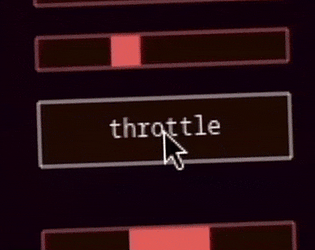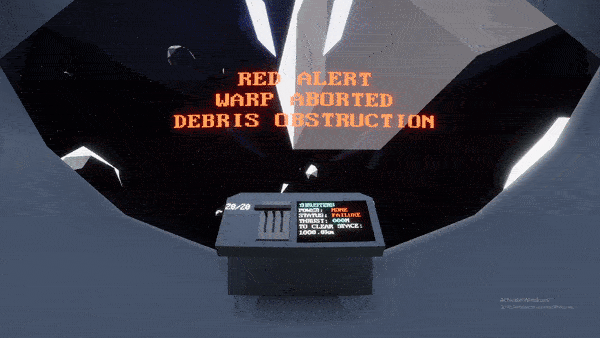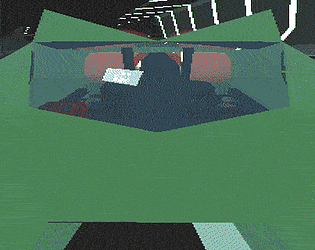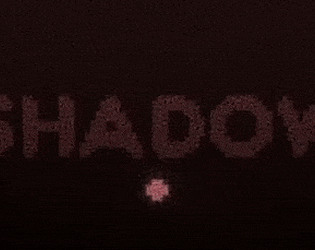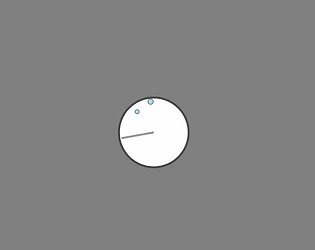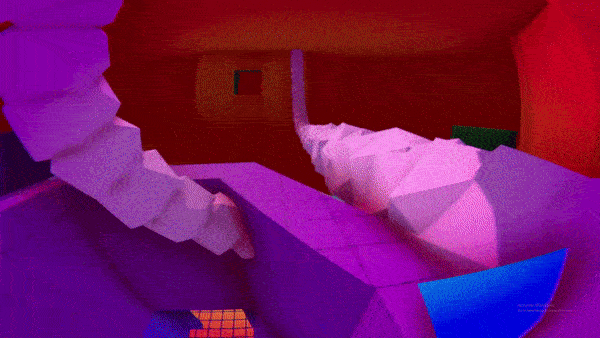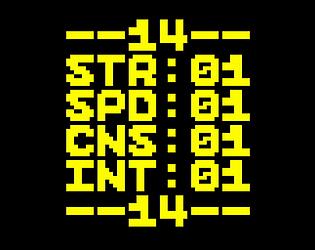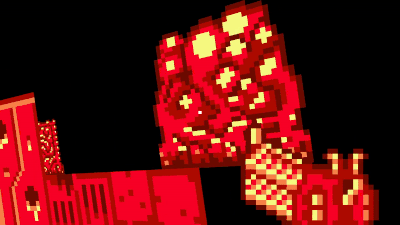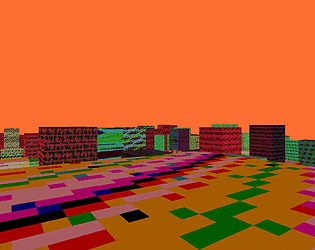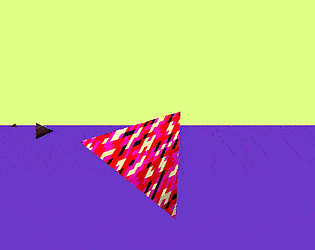'done' should move you to the next screen. have never heard of a bug like this. maybe try a different browser, or the itch desktop app?
acgaudette
Creator of
Recent community posts
hey! if you install the itch desktop application, you can play this offline :)
thanks for the note! it sounds like maybe you're referring to the data broker / pilot rumors? full tutorialization is a little out of scope for what I'm trying to accomplish in this prototype, but I'd be interested in hearing how you feel after making a few predictions. if you were instead commenting on immersive mode as a whole, you might appreciate some of the more recent patches I've put up.
hey, thank you for all your kind words and feedback! when you say league play, are you imagining a kind of fantasy sport type scenario? that's really neat and not something I considered.
while I can't guarantee that this jam version will see future content updates -- although I'm not opposed -- I _can_ promise that I've been busy working on bigger and better stuff in the AUTOGRAV universe, including a small project you can expect to see on itch within the next few weeks :)
hey, really like the visual style. the x ray bullets are super neat. it's awesome to play with a bolt action, but I feel like it doesn't spray enough damage to warrant the long reload time -- seems like it should be a one shot kill? also it's sometimes unclear if I'm reloading the 'bolt' vs the gun -- might want to look at the feedback there.
I figure that probably a lot of players are going to struggle without getting out of the opening zone until they think to rocket jump. might want to throw this info down somewhere?
anyways, good work! feels clean!
good job! the puzzles are good, and the mechanics are executed well. as others have pointed out, I think the most critical things to polish are probably (1) making the mirror worlds easier to distinguish and (2) cleaning up the touchy spike collision readability (it's a little unclear to the player where the spikes are triggered in relationship to the player model).
(1) is kind of interesting because, looking at your cover image, it's clear you had a valuable insight about this already. picking a color and its complement (orange, teal) is a great way to visually distinguish what the player sees. try something along those lines? or perhaps make buttons different colors on different sides of the mirror -- the buttons were the thing that confused me the most.
for (2), I would maybe just try a different player model altogether. I don't know what your vision is for the look of the game so I can't say much here, but something with clearly defined boundaries would probably help. zarvot is a random game that comes to mind.
good work!
great job! all the gameplay elements make sense. this is good work. I felt like it was a little too easy to run and gun cqb style -- you are probably going for more roof leaping moments -- a potential fix would seem to be making the ground units react more quickly and in more force.
I really like the slow reload, and forgetting to load the rifle when running away is a great moment, but it can get a little finicky sometimes when you don't time the animation just right.
also, it wasn't immediately clear that the cloud effect was more than a visual, so the first couple plays I totally missed out on this element.
these are all minor points though. great work! you should get this in playtest if you haven't already.
a couple random ideas for balance I had while playing:
- flying is unlimited, but you can only glide (lose height) and have to climb in some other way. I fell into the water multiple times and almost died because I ran out of stamina
- instead of running through the cloud, maybe you have to grab a body and fly away with it to trigger a 'feast' action, kind of like hiding bodies in trad stealth games but with a twist
great work. really enjoyed this. the hard light and shadows do a lot to sell the look. love the props. the UI feels really diegetic despite just being text. the velocity UI element is great.
I totally feel like the shotgun should push you back. seems like it would be a great feeling? maybe you could also have some resource management with the flashlight battery. oxygen and propellant were great but I didn't find myself caring too much during the game -- but that's fine and probably intentional.
I really liked the reload interface, which reminded me of a stripped down receiver. when engaging enemies though, I never felt like I was taking any real risk. making that more impactful I think would go a long way.
in-world text was great too. awesome job!
great work! I had a play moment that you were probably designing for -- someone looked directly at me and I instinctively dodged out of the way instead of standing still. it was great.
level design is awesome. the 'eye' ui element felt very slick once I figured out what it was. the 'blood' ui element felt kind of weird -- it felt like it was moving in reverse. I didn't immediately connect my death with my ammunition.
I enjoyed the weird low player controller. it did lead to some confusion early in the game though, when I couldn't figure out if I was underwater or not and needed to platform differently or do strange 6dof stuff. probably more a product of 7dfps expectations. once I made it past that I really enjoyed the game.
I do feel like there were moments where I should have been punished for moving, and moments where the AI didn't react to boxes. that could have been in my head though. awesome job!
hey, great job! I did a few playthroughs. feels snappy and fast, which I like. more quake than cs -- seems to fit the ghost in the shell universe.
clearly you spent time on the look and it's visually consistent. music and audio are great -- good job! have you played blacklight? seems like you're moving in that direction -- they also dig this sort of orange palette gritty look.
my biggest piece of feedback is probably that you need more [audio, visual] feedback on taking damage. I had no idea I was about to die in the first two playthroughs and was surprised when I did. it's difficult to learn what punishes behavior and what does not. in particular it's unclear what kind of risks you can take when engaging the mech -- I'm pretty sure I figured out how to cheese it by standing on top of it, or right under it. because its behavior is pretty straightforward, the damage requirement to destroy it can feel like more of an annoyance / grind than a boss battle.
having both E and space is maybe strange; not sure. I did enjoy using it as an escape button. maybe keeping the high jump and adding a slide or dodge is what you're looking for?
also, I feel like the basic enemy type could be more of a challenge. I like going for one taps a lot but it doesn't feel like there's a lot standing in my way there. I would like to be using cover more too.
anyways, great work! impressive stuff, glad the team came together.
but there's still something curious about simply not giving players most of the choices in the game. i.e. it's possible to make a game with relatively high headroom, but low repetition just by having a lot of content that doesn't appear every run.
I think you're getting at what (I believe at least) is missing from the headroom framework. Alex Smith would appear to value player choices only with regards to their relative probability of reaching a final win state, but this disregards how such a probability is actually computed: in general, the chance of victory depends on future choices, such that the value (sometimes referred to as the 'return') of a choice is actually a composite of every future choice in the chain of choices that make up a playthrough.
more plainly, two choices may have an equal likelihood of victory, but differ (e.g. in length, or composition) in how this likelihood is actually computed. despite their apparent similarity, they can actually be quite different, and in fact quite meaningful to the player, i.e. meaning is clearly not fully represented by the 'probability of victory' signal as Alex Smith would seem to claim. to reuse an example from the article: if two characters play very differently--so differently that learning one teaches you nothing about playing the other, say--but otherwise present equal opportunity for success, I would consider character choice to be meaningful: it determines the rest of your game!
there is something orthogonal to the notion of headroom, I think, and being unaware of it can lead to dangerous conflation (particularly 'high headroom' and player creativity). as you point out, the degeneracy of a 'puzzle' experience (there is only one path) is not the same as low headroom. ultimately what seems like poor design, at least in the context of these sorts of games, is making only one path viable. I think that you can give the player plenty of creative choices early on, as long as they have to pay the price for these choices eventually... and that's what I think could be neat about shroom & gloom, at least in the early game.
on the other hand, giving the player too many options probably overwhelms them with choice and/or puts them in a rut, as you say. this would seem to relate to player creativity in general. this post focuses on sandbox games, not roguelikes, but I am surprised to find that it has some relevance here. offering the player three cards and telling them to make a decision feels a lot like giving the player an interesting and functional design constraint.
regarding farming. at some level I believe that farming (and stuff like exhaustive inventory management) is just 'bad', at least in the sense that it's unintentional (i.e. as opposed to a game 'about' farming). regardless of the value of the reward (and sometimes in spite of it), the cost of farming is usually only player time, and player time is a valuable resource. either just give the player what they want, or incorporate some kind of risk/reward tradeoff into farming, right? curious if you agree. I mentioned this already, but one thing I liked about shroom & gloom was that it puts a negative feedback loop on inventory management. if you try to hoard tons of cards in your home deck, you'll just weaken its draw power overall. I would probably enjoy if farming was given a similar treatment.
this segues somewhat neatly into your other comments.
the thing about CCG's in general, is that the random-draw-from-a-deck is naturally great at getting players to improvise . . . I feel like there's got to be a way to disrupt a farming strategy through introducing more randomness, like if the first half of a run involves a lot of farming, but then some event takes place half way that provides an even better approach, that would reduce the overall repetition, and as I see it the repetition itself is the problem.
I would like to push back a little against this, but not much, because it's more important to preserve your take--particularly in a genre game like this.
but I would say that the whole point in building a deck, from the player's perspective, is to make something that consistently delivers exceptional performance. in order to do this, you need to be able to understand your deck in its totality--you need control. deckbuilders feel like a battle against the machine, where the player always wants more control but is (positively) constrained by some aspect of the design. MTG (which I have very little experience in) has a minimum deck size for this reason.
so when a card shows up in my hand, I already know what to do--it's part of the engine. this is because it is common in these sorts of games to have total information when it comes to the composition of your deck. understanding your deck is knowing all the hands you could draw, and this information isn't gated by anything (in particular: time) so investing into this sort of knowledge can be seen as a weakness in the player that is either encouraged or discouraged by the design. a little like farming I guess. so the extent to which players 'should' improvise I think is very low, or at least the game as it currently exists does not encourage this in play. you could however imagine several changes that would (not knowing what's in your deck is the obvious one, but also cards that mutate in the background, or cards that synergize very broadly, etc.). I am sure slay the spire supports large 'grabbag' decks--I am not a serious enough player to know--but there has to be something that makes these viable, otherwise you just draw into a lot of terminal cards.
oh ho. an expert--that's a good one! did get into dominion a little back in the day, but I don't do much with deckbuilding in my own design practice, unfortunately.
some final thoughts. did one last playthrough (it's fun!). was able to farm the positive feedback cards (I think there are two? 'raging edge', which quickly spirals out of control, and something something blade) pretty successfully. it looks like one of you may have capped the total mob count to ~20, or at least it seemed that way, since some squid thing just flat out stopped calling for reinforcements. by the end of it all I was dealing about 400 damage per turn.
there are many ways to combat this kind of thing. slay the spire I think features several enemies with positive feedback loops of their own, making lingering in encounters incredibly punishing. you do a little bit of this with the shield buff squid. but really you might just want to apply reinforcement actions more delicately, and pair them with powerful opponents (which check the player) rather than making it a thing you can always just do.
I'm definitely not against easy trashing--it can be a powerful creative tool for the player. but perhaps if you go down that route, you might consider balancing it against something else. all roguelikes sit somewhere on the control/constraint creativity spectrum, right? i.e. whether you're forced to play the hand you're given (pun intended) or you have the flexibility to always make your own build, no matter what. this has apparently been described as 'headroom' in the past: http://nethack4.org/blog/strategy-headroom.html (kudos to my jam partner Elliot for sharing this with me recently). what I like about shroom & gloom is that the cards feel more component-based and buildable than the typical deckbuilder, but maybe you're not trying to move in that direction. I mean, if you don't, I will! :)
speaking of which: it seems as though there are no tradeoffs to all the stacks you can put on cards. one common strategy I had, which feels degenerate, is just to load everything useful on one uber card that I know I'm never going to lose.
finally, here's a dumb thought. I realized that you guys are one key away from a mouse-only game. don't get me wrong, the W card is gorgeous, but if I could just click to move forward I could throw my keyboard away and put my feet up. the ultimate lazy day.
neat concept! I like the puzzly, slow pacing take you gave this mechanic--I think it really works, and I enjoyed it. somehow this really feels like it could be one of those 'hl2 mod but we released it' games. must be the tone, and the turrets.
I do think the pacing contrasts a bit painfully with the lack of checkpoints though. normally I welcome difficulty, but punishing the player so harshly for exploration (which seems to be quite central to how this game plays) seems a bit unintentional. nevertheless, this is a minor point.
the first turret death is communicated well. or at least it makes sense in retrospect--the first time it happened to me I had no idea what was going on.
the invisible zones are neat, and the "don't clear the backbuffer" effect is very cool, but it makes traveling through doors impossible. when you noclip straight through a door (the first action I took as a player) it very much looks as though nothing is happening. took me awhile to realize that wasn't a literal bug.
I really like the orientation lerping. I can see how this might trigger a certain kind of person, but it doesn't affect gameplay and I enjoy the way it feels.
overall, great work! seems like something that would fit well as a bite-sized narrative puzzle experience, i.e. it would seem to depend heavily on content. curious if you have similar thoughts.
a few minor, unimportant polish points:
I often released RMB and tapped LMB at the same time to teleport, which appeared to trigger RMB first (which was annoying). probably not what you want to happen?
if you mark your zip as a windows target on itch, the desktop client will be able to auto-install and play it (as opposed to the webgl build, which installs and bugs out by default on the desktop client)
the vertical axis wobble is indeed the intended input mechanic. the critical observation to make I would hope is that it allows you to decouple the gun orientation from the head orientation, so that you don't have to wave your camera all over the place just to shoot. instead, you can focus the camera on your intended target, and then swing the gun 'through' it, while staying 'aimed' at it the whole time. the purpose of RMB is to stabilize the gun before and after the swing, but not during.
I believe this is reaching the limit of my ability to describe these things in words :) and I realized itch allows you to embed gifs, albeit at terrible quality:
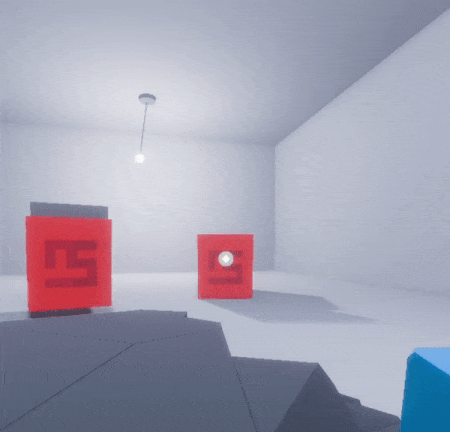
it's quite possible that the sensitivity of the flicking action is just too high by default.
your comments on incremental level design are accurate and incisive.
and yes! catching bullets is a thing. however, it's much harder to do than dodge, and we didn't have time to implement a useful reward for doing so.
that being said, developer-hard is probably an accurate description! the turret takes two shots to kill. you can either hit it from the top or from the sides. it's somewhat easy to cheese if you crouch under the low cover behind the pillar and lob shots on its head. once you hit it once, there's 3-4 second stagger where you can just directly shoot at it to knock it out.
thanks again for stopping by! if you have any tips for how to improve readability or intuition-building we would love to hear them.
you're good! thanks for playing, and dropping your thoughts. Elliot was responsible for the enemy design, including most of the sounds, and I'll definitely pass on your kind words.
you can swap cover with L1 (or whatever the bumper is on your controller), which triggers the bullet time. this is much more noticeable on the endless level, where you can challenge our high score (which very few remote players have as of yet, because the turret is proving to be the ultimate, impossibly hard gatekeeper).
then again, it's possible you didn't realize that the controller was used for body motion at all (oops!), in which case it would make sense that you were unable to dodge the bullets. on the jumping blocks level, you can dodge more or less 100% of bullets by just flicking the stick in any direction or holding down L2 when it's coming at you.
so, that being said, with regards to your main points:
your note on depth perception is right on the money, I think. it seems reasonable to claim that, in lieu of being able to accurately make a quantitative estimate, the player must fill in the gaps somewhere else. it would seem that this could either come from history (either map knowledge, which I think is significant--think golf courses, right? or a more local sort of history like you point out: just the previous shot) or perhaps some kind of live prediction.
the thing is, the bullets (or the gun, depending on how you see it) have a fixed velocity, and as my partner Elliot pointed out several times, that gives them an inherent 'working range'. the gun we shipped with has a sweet spot, a range (I dunno, something like 4-12 meters) where curves are relatively easy to control and the margin of error is (or so we hope) reasonable. outside of these ranges it begins to get difficult, more like a 3 pointer in basketball, and you have to compensate in other ways. so the golf club analogy kind of holds, in that there's a spot you want to hit which provides its own margin of error (the size of the enemy), and a 'club' that has a sort of working range and height (the gun).
the real question I think you're getting at is whether it's reasonable to expect that, as a player, investing your time in practicing this weird thing has any promise of making you any better at it. you're alluding to the potential existence of a sort of physical barrier--either in humans or in the game's presentation--that means your experience will just eternally be suboptimal and therefore unfun. and how can you know for sure, given that a hundred guinea pigs haven't come before you and proven that it can be done? if I were you, I'd be suspicious.
I'm not sure that I have a direct answer. but I do agree, and you are making a good point, that we pile on a lot at once. stick peeking and particularly stick dodging I believe feels rewarding once you get into it--and motivates the controller as an input method--but for new players, becomes just one more thing to manage while dealing with the already very hard shooting scheme. designing play environments (as you say) around some of these more basic concepts seems like a valuable direction.
thank you again!
thank you for the detailed feedback! it means a lot!
before I get to the meat of your comments, I have a quick response that you may or may not find valuable. from playtesting, I've observed that there seem to be (roughly) two kinds of players: the kind that holds down RMB all the time, and the kind that swings the gun like a 'hammer'. the holding down RMB case was actually how we had the mechanic implemented, period, for the first couple days. at this point I see it as more or less a degenerate outcome (and a reflection of a design flaw if players end up shooting that way). playtesting this game asynchronously (versus watching someone play over their shoulder) has been a little nightmarish, if you know what I mean.
the intended way to shoot, at the very least, is to create and execute a 'swing' with your gun, a little like you would swing a golf club or a tennis racket. first you press (and hold) LMB, then you 'push' the bead up with your mouse. next, you 'pull' the bead towards center with your mouse, and release LMB when you want to fire. because the amount of spin is directly proportional to the velocity of the bead, and this 'swing' is a (relatively) slow process, the margin of error is increased and it becomes easier to hit shots consistently. of course, this takes a fair amount of practice. at this point I can blitz through the intro maps pretty quickly.
I'm interested to hear if this works for you, and if it does (or doesn't) I would be interested in any feedback you have for improving how we communicate this to the player, even if it's as simple as a better description on the itch page or a real tutorial. either way, thanks for playing!
did a second run today. pleased to find that my build ended up significantly different than the first one!
managed to beat the game this time around but it felt like a bit of a cheese. picked up the 'everlasting truffle' very early. it's difficult to see how this isn't op; you can easily farm the card on low-level mobs and pick up a huge amount of hp. given that the card title also clips off the sprite, part of me wonders if it was a debug item? it doesn't seem to be more valuable for cooking, either. even if something like this was balanced as a viable strategy (say, by throwing in a bunch of health trading cards), it still seems a little rough to have to grind with it in the early game.
I do appreciate the biphasic decks. having useful items as cards motivates interesting player choices--your draw potential is hurt by hoarding valuable stuff--and the risk v reward feels like good design.
that being said, it was unclear if you can shuffle your 'home' deck? I should have paid closer attention but it seemed as though sometimes I can't draw into what I expected. on my first playthrough I was fairly confused about drawing and shuffling after a fight vs on entering a safe zone. I'm reasonably convinced that it works mechanically but from a readability perspective it could probably use a little love.
the relationship between truffles => the campfire is fairly unclear, but the rest of the game stands on its own so that's OK. feels like more of an easter egg than a mechanic. once I did pick up on the crafting, the items didn't seem more useful than my actual deck. but that was just my initial impression.
having card trashing handy with the pig is nice. that being said, my deck never really felt bloated. you start with very few cards, and because trashing is so easy, you can trivially thin your deck. perhaps this is intentional--it's certainly your choice--but it might put more pressure on the player to make this a less accessible strategy.
the damage cards also feel somewhat fungible. this is again something I like--I'm excited by the idea of modding and mashing up cards in this style of game, and I think it's a powerful design direction--but it's too random to feel like a significant player choice.
ultimately, it feels easy to become very powerful. my draws were almost always good. I can almost always get my cake and eat it too. this is something I like about the game overall. but this might hurt replayability. not sure--I've only played it twice, and this is only a demo. probably though you want a little more deck difficulty, as opposed to just making the enemies harder.
again, overall, great work! happy to answer any playtest Qs, but I'm sure you guys have a local scene there to watch people play live.
thanks for playing! elliot will be happy to hear you liked the cubes--those were all him, grunts included.
re: your personal sensibilities, this just feels like one of those games where the difficulty is sort of intrinsic to the core mechanic. that being said, the game does lob you right into the deep end! we could have done a better job of scaffolding and tutorialization for sure :)


